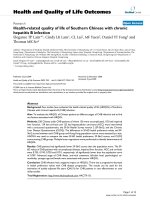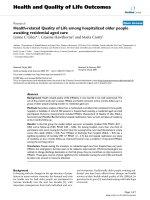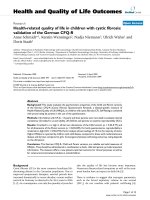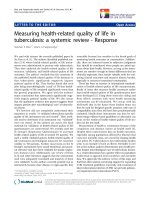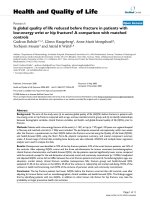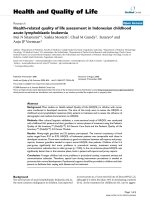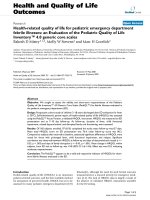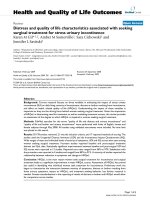báo cáo hóa học: " Measuring health-related quality of life in tuberculosis: a systemic review - Response" potx
Bạn đang xem bản rút gọn của tài liệu. Xem và tải ngay bản đầy đủ của tài liệu tại đây (177 KB, 2 trang )
LE T T E R TO THE EDITOR Open Access
Measuring health-related quality of life in
tuberculosis: a systemic review - Response
Stephen E Weis
1*
, Jotam G Pasipanodya
2
We read with interest the r ecently published paper by
NaGuoetal[1].Theauthorsidentifiedpublishedstu-
dies [2-4] where health-related quality of life instru-
ments were administered to persons with tuberculosis.
They then analyzed the health-related quality of life
structure, validation, and health-related quality of life
outcomes. The authors’ conclude that the con sensus of
the published health-related quality of life literature is
that tuberculosis significantly negatively impacts
patients’ quality of life. They further found that even
after being microbiologically ‘ cured’ of TB that health-
related quality of life remained significantly worse than
the general population. We ag ree with the authors ’
major conclusions that tuberculosis significantly nega-
tively impacts patients’ quality of life. We also concur
that the qualitative evidence they present suggests these
impacts persists after microbiological ‘cure’ of tuberculo-
sis disease.
We however did not completely understand their
statement in results, “A validated tuberculosis-specific
quality of life instrument was not located”. Their meth-
ods used to determine if an instrument was “validated”
were not stated. As the authors are aware, the ideal
methods for validation of health-related quality of life
questionnaires are controversial. We recently used the
St George’s Respiratory Questionnaire to ascertain
health-related quality of life in treated TB patients. We
used a widely validated generic health-related quality of
life instrument and biological measures for construct
validity in TB patients. Further most items in the St
George’s instruments have sound theoretical and practi-
cal relevance and have been validated for similar respira-
tory diseases [2,5]. Additionally, our review of these
[2-4] and other literat ure suggests that the instrumen ts
used were adequately translated and majority of them
were validated. As the authors correctly pointed out, as
instruments become more disease or organ-specific they
invariably become less sensitive to the broad goals of
measuring health outcomes in communities. Addition-
ally, there are inherent biases in subjective judgments
that should be considered when people are asked opi-
nions about their health. However, as long as the instru-
ments are sensitive enough to detect differences that are
clinically important, they remain valuable tools for eval-
uating clinical outcomes and mea sure disease burden,
especially in resources-constrained communities.
There has been an increase in international standardi-
zation of health-related quality of life measurements.
Banks of items that measure health constructs rather
than health-related quality of life questionnaires have
been developed [5]. Using these items the ceiling and
floor effects common with most health measuring
instruments can be minimized. We concur with Ian
McDowell that in the future these banked items can
then be used for designed specific purposes with ease of
comparability since they will have been psychometrically
evaluated. Ideally these instruments can then be vali-
dated using evidence-based guidelines so discussi on can
focus on the results of health-related quality of life stu-
dies not the test itself.
Measurement of health is contentious because of the
complexity and abstract nature of health itself [5].
Despite these controversies data on health outcomes,
especially among populati ons affected by illnesse s that
cause low mortality rates, are crucial for shaping health
care policy [5]. Tuberculosis in low tuberculosis-burden
areas is an example of such an illness. Mortality is rare
but as the authors analysis demonstrates poor health per-
sists despite microbiological cure of tuberculosis disease.
As a result tuberculosis has a greater effect on population
health than is apparent from incidence and mortality
data. We appreciate the authors’ review of this topic and
find from their analysis convincing support for expanding
LTBI treatment guidelines. Currently only treatment of
latent tuberculosis infection (LTBI) can prevent pulmon-
ary impairment after tuberculosis (PIAT).
* Correspondence:
1
University of North Texas Health Sciences Center at Fort Worth, 3500 Camp
Bowie Blvd, Fort Worth, Texas 76107, USA
Weis and Pasipanodya Health and Quality of Life Outcomes 2010, 8:7
/>© 2010 Weis and Pasipanodya; licensee BioMed Central Ltd. This is an Open Access article distributed under the terms of the Creative
Commons Attribution License ( s/by/2.0), which permits unrestricted use, distribution, and
reproduction in any medium, provided the original work is properly cited.
Author details
1
University of North Texas Health Sciences Center at Fort Worth, 3500 Camp
Bowie Blvd, Fort Worth, Texas 76107, USA.
2
Division of Infectious Diseases,
UT Southwestern Medical Center, Dallas, Texas, 5323 Harry Hines Blvd, Dallas,
Texas 75390-9113, USA.
Authors’ contributions
Conceived and designed the study; JGP, SEW.
Collecting data; JGP, SEW.
Analyzed data; JGP, SEW.
Write manuscripts; JGP, SEW.
Both authors read and approved the final manuscript.
Competing interests
Both authors have no completing interests in the subject discussed.
Received: 19 September 2009
Accepted: 19 January 2010 Published: 19 January 2010
References
1. Guo N, Marra F, Marra C: Measuring health-related quality of life in
tuberculosis: a systemic review. Health and Quality of Life Outcomes 2009,
7:14, doi:10.1186/1477-7525-7-14.
2. Pasipanodya JG, Miller TL, Vecino M, et al: Using the St George Respiratory
Questionnaire to Ascertain Health Quality in Persons with Treated
Pulmonary Tuberculosis. Chest 2007, 132:1591-1598.
3. Muniyandi M, Rajeswari R, Balasubramanian R, et al: Evaluation of post-
treatment health-related quality life (HRQoL) among tuberculosis
patients. Int J Tuberc Lung Dis 2007, 11:887-892.
4. Dhingra VK, Rajpal S: Health related quality of life (HRQL) scoring in
tuberculosis. Indian J Tuberc 2003, 50:99-104.
5. McDowell I: Measuring Health. A Guide to Rating scales and Questionnaires
Oxford University Press, Third 2006, 10-46, p704-709.
doi:10.1186/1477-7525-8-7
Cite this article as: Weis and Pasipanodya: Measuring health-related
quality of life in tuberculosis: a systemic review - Response. Health and
Quality of Life Outcomes 2010 8:7.
Submit your next manuscript to BioMed Central
and take full advantage of:
• Convenient online submission
• Thorough peer review
• No space constraints or color figure charges
• Immediate publication on acceptance
• Inclusion in PubMed, CAS, Scopus and Google Scholar
• Research which is freely available for redistribution
Submit your manuscript at
www.biomedcentral.com/submit
Weis and Pasipanodya Health and Quality of Life Outcomes 2010, 8:7
/>Page 2 of 2
